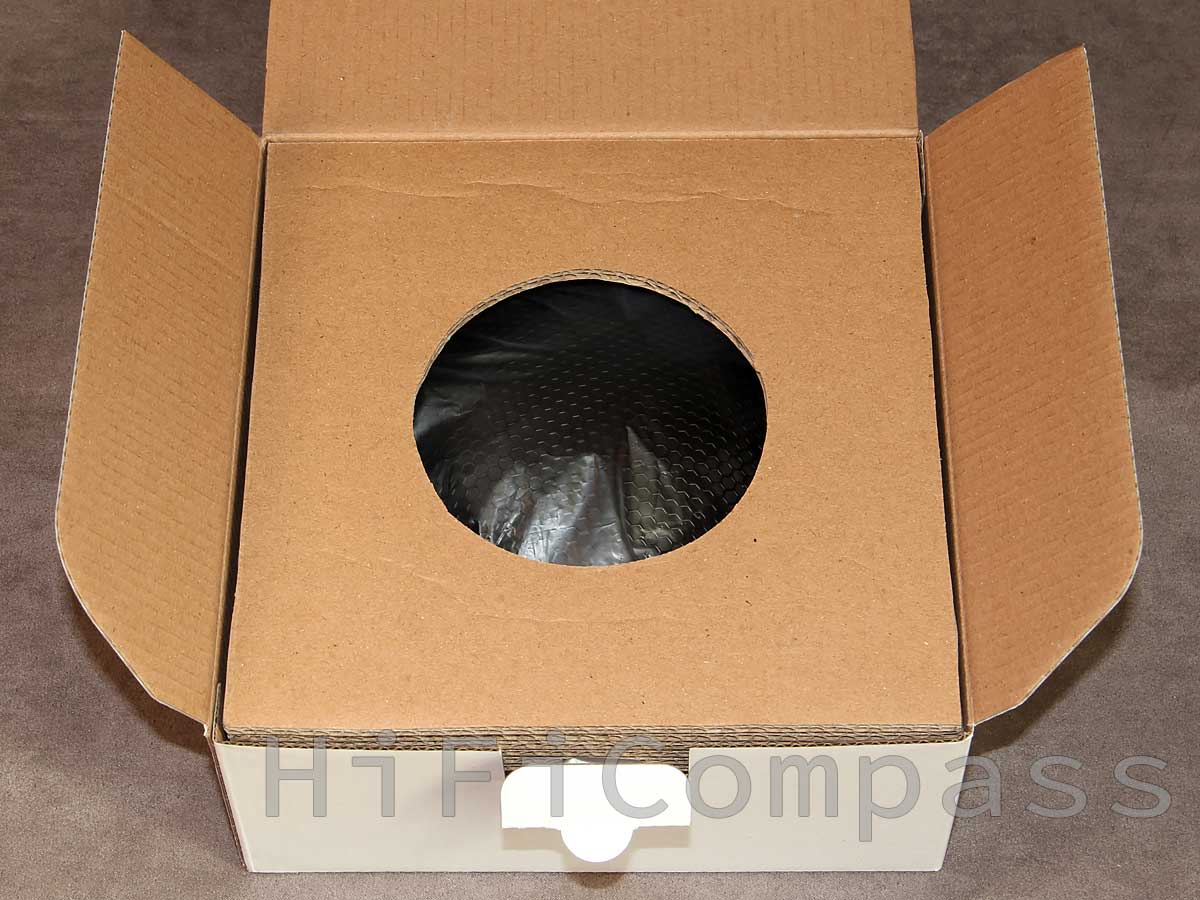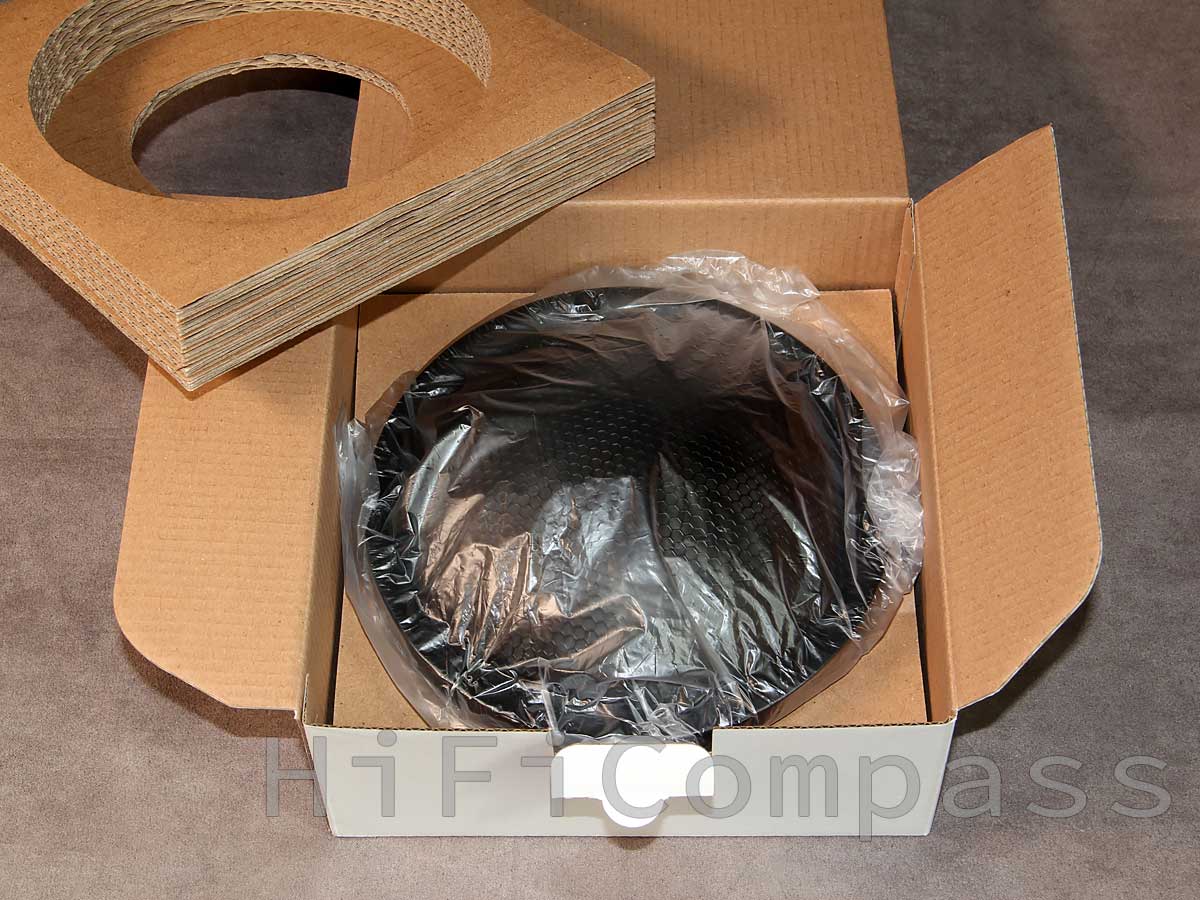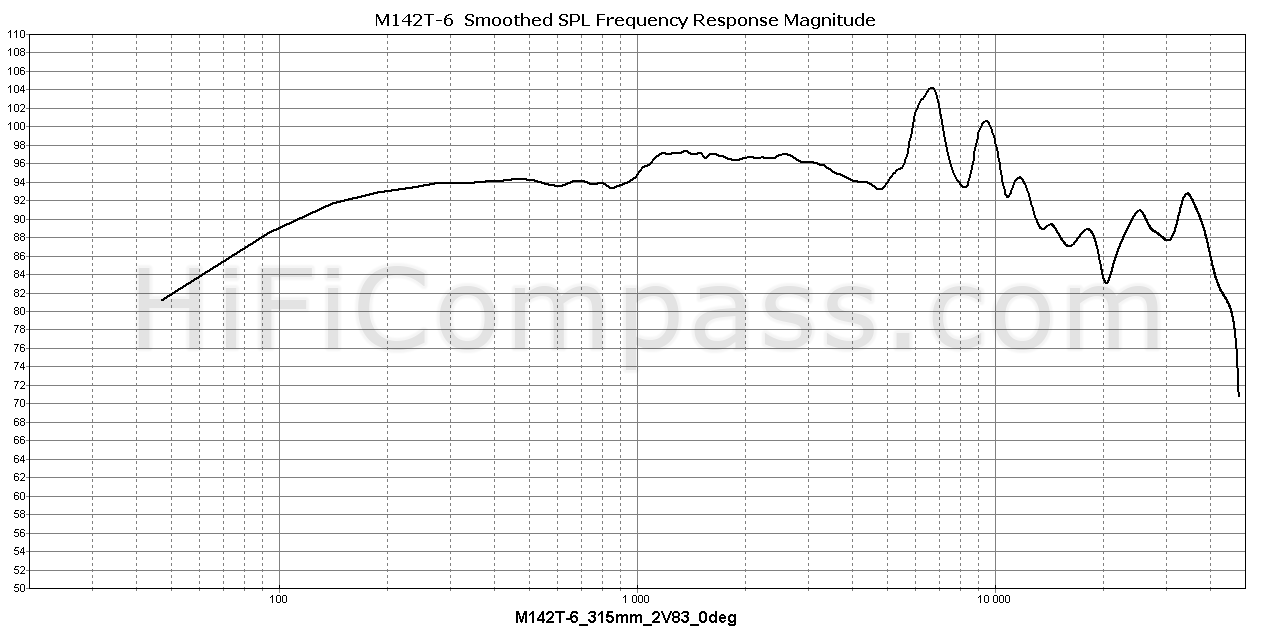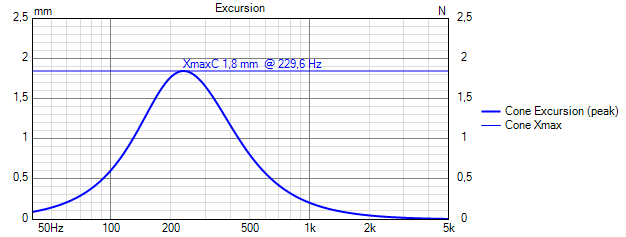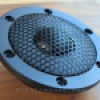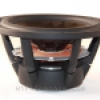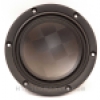HiFiCompass
BlieSMa M142T-6 7" TeXtreme dome midrange
At the annual HighEnd-2024 exhibition in Munich German company BlieSMa presented another model of large 7” dome midrange M142T-6, which we are going to get acquainted in this review. The company's portfolio already includes extraordinary 7” dome midrange drivers with aluminum diaphragms (M142A-6 review) and paper (M142P-6 review), and now it's time for their version on the now super trendy TeXtreme material.
TeXtreme is a new term that burst into the “high end world” in the spring of 2019 after AudioXpress magazine published an article about Swedish company Oxeon's introduction of the newest type of speaker diaphragms - TPCD (Thin Ply Carbon Diaphragm) based on TeXtreme. Since then, the first TPCD diaphragm speakers to hit the home audio market were Satori-branded speakers, followed by SEAS, and this year it's time for Scan-Speak and BlieSMa.
As far as I know, BlieSMa is the only company making such giant dome midrange speakers. Here are the main ideas behind the concept of these unusual speakers:
- Increasing the size of the diaphragm makes it possible to reduce the amplitude of its excursion at a constant sound pressure, which helps reduce the Doppler effect and all types of nonlinear distortions compared to smaller midrange drivers
- A large diaphragm size always has the opposite effect of narrowing the radiation pattern and lowering the maximum upper operating frequency, so the convex dome diaphragm! Thanks to this, the directivity pattern is noticeably broadened and even outperforms "cone" competitors with smaller diaphragms
- One more conceptual idea behind of BlieSMa M142T-6, M142A-6 и M142P-6 midrange is working together with large dome BlieSMa T34A-4, T34B-4 and T34D-4 tweeters. The convex dome shape of the diaphragms of the midrange and tweeter contributes to a significant convergence of their acoustic centers in the direction of the main axis of radiation and approximation to a time-coherent loudspeaker
I would like to express my great gratitude to Stanislav Malikov, the BlieSMa's designer and owner, for providing samples of the M142T-6 midrange speakers for testing.
Here you can get familiar with the BlieSMa history.
What did the manufacturer state?
Getting familiar with the technical data sheet:
Of the numerical parameters it is worth to note the low mass of the moving system, only 10.9 grams at the radiating area of 180 cm2, very low inductance - 0.03 mH, high mechanical quality factor Qm=9.2 and huge diameter of the voice coil - 137 mm.
The sensitivity is quite high, 94.5 dB/2.83 volts. Linear excursion is not 6 mm, as in a bass driver, but only 1.85 mm per side, but this is compensated to some extent by the large diaphragm area, and don't forget that this is a midrange, it doesn't need a large excursion like a bass driver. We will come back to this issue in the "How to use" recommendations section.
Among the design features, I was pleased with a natural silk surround - for a true midrange speaker this is important, a huge single-layer voice coil with a ribbed wire, and an underhung-type motor with a copper sleeve.
The datasheet provides additional frequency response graphs for the rear radiation. They can be really useful for those who are considering using the speaker in open back designs. As we can see, the "rear" responses repeat the "front" ones quite well, with the exception of the 800 Hz – 2 kHz range.
The ordinary but quite reliable package made of sturdy glossy corrugated cardboard. Inside, the speaker is fixed with cardboard inserts with shaped cutouts.
But the speaker itself is very far from an ordinary one. For the first time I took it in my hands and examined it from all sides, from different angles and even armed with a magnifying glass. What kind of a beast is this? A huge dome diaphragm behind a grille at the front, and a massive metal ring and a huge donut hole at the back - that's the whole speaker! I think the above pictures will make your brain work a little harder too.
After 10-15 minutes of close examination, the puzzles of this design gradually begin to form in my head. The familiar basket has not quite the usual look - it is a 180-millimeter aluminum ring with a height of 7 mm with four thick, but very short legs, on which the underhung magnetic system is held. On the back side, the basket has a foam rubber gasket around the entire perimeter.
The magnetic system is a massive circular steel magnet core, encompassing a huge circular neodymium magnet on the outside, of which only the inner side surface is visible. There are 12 small holes around the perimeter of the magnetic core to provide ventilation for the voice coil, which is completely hidden in the magnetic gap and completely inaccessible to the eye. However, the 137(!) mm diameter titanium voice coil former, which is densely perforated, is clearly visible through the gap between the basket and the magnetic core.
The four-wave spider is made of natural cotton by the German company Dr. Kurt Muller. Such spiders are characterized by low mechanical losses and are particularly good for use in midrange speakers.
The half-roll inverted surround is made of natural silk, also by Dr. Kurt Muller. From the rear, it is very clearly visible in its entire size, but from the front it appears much narrower because it is partially covered by a thick, about 9 mm, aluminum ring to which the grille is attached. This ring has three main functions: decorative - it covers the joint between the surround and the basket, functional - it reduces the outward protrusion of the dome profile, and load-bearing - the grille is attached to it. It also has six holes with pockets for the heads of mounting screws.
Through the huge opening in the magnet system you can see the back of the dome diaphragm with the characteristic “checkerboard” weave of wide TeXtreme ribbons. In the M142T-6, the diaphragm has just one layer, minimizing the weight of the moving system. So far, all the speakers I've used, even the tweeters, have had two or more layers of TeXtreme diaphragms. There is a slight surface relief to the touch.
On the front side, the diaphragm has the same pattern as on the back side, but its surface is perfectly smooth and matte. The convex profile of the diaphragm is quite high and protrudes about 25 mm from the basket.
The diaphragm is protected by a metal grille with a high degree of transparency, at least 70%. The grille and all aluminum parts are protected by a durable semi-matte powder coating.
The workmanship is of the highest quality. No glue marks, scratches, dirt and dust, stains or dents on the diaphragm as well as no chips, gaps or dents on the diaphragm. Absolutely nothing to complain about.
In the hands, the M142T-6 gives the impression of a solid monolith. All components are absolutely inert when tapped, and there is not the slightest hint of any extraneous sound.
Overall, the speaker made a pleasant impression with its unconventional design and excellent workmanship.
The diagrams below show the frequency responses of the impedance at different scales:
The measured values of the resonant frequency Fs=64.6 Hz, total quality factor Qts=0.3151 and mechanical quality factor Qms=8.966 practically coincide with the declared values, the differences are within the limits of measurement error and production tolerances.
The impedance curve above 200 Hz is virtually flat, with a rise to 20 kHz relative to 500 Hz of less than 45%, reflecting the extremely low inductance of the voice coil. This low inductance (0.03 mH) is due to the short (2 mm) single-layer voice coil and the massive copper sleeve in the magnetic gap.
The spikes at 6.8kHz and 10.5kHz reflect the first two most significant resonances of the rigid diaphragm of TeXtreme - quite natural and inevitable. The hump at 1.1kHz, on the other hand, is quite unexpected. Usually in this range there is an echo of the characteristic resonance of a surround and an edge of a soft cone diaphragm, but in the case of the M142T-6 this effect should be absent at all, because the interface between the surround and diaphragm is supported by the rigid titanium voice coil former. In fact, it is caused by an acoustic effect due to a parasitic Helmholtz resonator formed by the compliance of air in the diaphragm subdome space and the mass of air in the short “tube” of the magnetic system. This is a very unpleasant effect, but we will return to it a little later.
So, the impedance measurements told us about a moving system with very low mechanical losses, a very good motor that promises low nonlinear distortion, and the presence of parasitic resonance in the subdome space.
On-axis frequency response (at 315 mm)
Below are the axial smoothed (1/12 octave) and unsmoothed frequency responses of SPL of the M142T-6 measured in a test baffle at a distance of 315 mm to a measurement microphone at 2.83 volts:
The frequency response is very close to the datasheet, but the step at 1 kHz is more gentle and lower in height. Due to the stepped shape of the frequency response, the average sensitivity can be estimated as 94 dB in the range 300 - 900 Hz, and 96.5 dB in the range 1.2 - 3.2 kHz.
The horizontal section of the frequency response extends up to 5 kHz, however, it can't be called flat because of an unpleasant step with a height of about 3 dB in the region of 1 kHz. Above 5 kHz the diaphragm switches to the breakup mode of operation, which is accompanied by a series of resonances of different strength.
In principle, only the first two resonances at 6.8 and 9.3 kHz are clearly observed, manifested by spikes of about 10 dB and 7 dB height respectively. The spikes are quite neat, narrow and symmetrical, so combating them with conventional notch-filters in a loudspeaker crossover will not present any difficulties. After the spikes higher in frequency, the frequency response acquires a declining character with slight undulations, which indicates good control of the diaphragm breakup mode.
As you have already noticed, the M142T-6 midrange is not like any other. Its original design, while offering a number of advantages, faces problems that classic concave cone diaphragm designs never do. It is, of course, about the sub-dome resonance and its manifestation in the form of a step in the frequency response in the region of 1 kHz. This problem can be solved in the traditional way, indirectly, namely to fight the symptoms of the disease and elementary correct the step with the help of DSP in systems with active filtering, or do the same in a passive crossover, even if it is a little more complicated. Fortunately, the manufacturer does not leave us with the problem alone and for a non-standard speaker offers a non-standard approach, fundamentally eliminating the problem acoustically. The essence of the method, detailed in the document "M142 Series Application Note AN1", is to create a special acoustic load for the rear diaphragm radiation, neutralizing the parasitic sub-dome resonance. This method has already been tested by me during measurements of the aluminum M142A-6 and paper M142P-6 and proved to be effective. In order not to break tradition, I decided to test it on the M142T-6 as well, using exactly the same back enclosure and stuffing as for the above-mentioned speakers.
Below are measurements of the speaker in the test baffle as is - the black curve, and with the rear chamber - the red curve:
Wow, that's a completely different thing! The frequency response is magically transformed and became very smooth and even. The step has completely disappeared and the average sensitivity in the 300 Hz - 2 kHz range is already equal 96 dB which exceeds the datasheet value by 1.5 dB. I can say that this uncomplicated method demonstrated an excellent result and allowed the speaker to reach its full potential. Excellent!
Off-axis frequency responses (at 315 mm)
Below are graphs of off-axis frerquency responses - conventional and normalized, in which the axial response is taken as a reference, and the off-axis ones reflect only the difference with it:
And here comes the main bonus of the large dome midrange - a very wide radiation pattern. Even at deflection angles of 60 degrees up to 5.5 kHz, the sound pressure does not drop below 8 dB in relation to the axial pressure. This is especially impressive when you consider that the diaphragm area is as much as 180 cm2.
From the normalized graph, it can be seen that starting at 1 kHz, the off-axis characteristics monotonically decline until about 2.5 kHz, after which the decline stops until up to 5.5 kHz.
Some cone speakers with a radiating area of even 119 cm2, especially above 2.5 kHz, cannot boast such a wide radiation pattern (for example, Satori MR16P-8, SB17NRX2C35-4, 16W/4531G06, C173-6-090).
Harmonic distortion (at 315 mm)
Above are the dependences of harmonic distortion at voltages of 1.41 and 8 volts, which corresponds to average sound pressure levels of 88and 103 dB, respectively. The measurements were taken on axis at a distance of 315 mm to the microphone. To limit overloading of the speaker in terms of diaphragm displacement amplitude, a second-order digital high-pass filter with cutoff frequencies of 50 Hz at 1.41 Volts and 80 Hz at 8 Volts was used when measuring harmonic distortion. In these graphs, we analyze the frequency range only above 150 Hz.
At all sound pressure levels, the entire operating frequency range is dominated by an exceptionally sonorous second harmonic. Between 300 Hz and 3 kHz all harmonics are at a minimum level, only the second harmonic increases slightly between 800 Hz and 3 kHz.
Below 300 Hz, the usual increase in harmonics of all orders begins due to the increasing amplitude of the diaphragm excursion. Above 3 kHz all harmonics sharply increase, which, most likely, is connected in some way with the approach to the breakup mode of diaphragm operation.
In the range of 800 Hz - 1.2 kHz a slight rise of all harmonics is also observed. It is quite likely that this effect is somehow related to the under-dome acoustic resonance.
In general, I would characterize the overall level of harmonic distortion in the 300 Hz - 3 kHz range as “very low”.
Voice coil current harmonic distortion
This type of measurement, although simple, is a good tool for evaluating the linearity of a speaker motor. The graphs above show the frequency dependencies of the 2nd, 3rd, 4th and 5th harmonics of the voice coil current at voltages of 1.41 and 5.6 volts (with the second-order high-pass filter on with cutoff frequencies of 50 and 80 Hz, respectively).
Voice coil current nonlinearity is the direct nonlinearity of the mechanical force driving the speaker cone, since this force is related to the current by a simple relationship F=B*L*I, where B is the magnetic field strength, L is the length of the voice coil wire inside the magnetic gap and I is the current. So, it is practically impossible to obtain sound pressure distortion lower than current distortion in the frequency range where the contribution of the motional nonlinearity becomes insignificant.
The overall level of current harmonics of all orders in the frequency range 300 Hz - 3 kHz is very low. With decreasing frequency harmonics of all orders increase due to increasing amplitude of diaphragm oscillations. Above 3 kHz, the growth of even harmonics is due to the diaphragm entering the breakup mode of operation.
The overall level of current harmonics of all orders in the possible operating frequency range is very low.
The intermodulation distortion measurement is one of way of to analyze the device non-linearity. It is not an alternative, but an additional method and allows you to identify the spectral components of the inharmonious structure, which are much more harmful for high-quality sound reproduction and to which our hearing is more sensitive.
For testing I chose the frequencies with ratio (1:8.5). In this case the Doppler distortion is not yet dominant and the contribution of amplitude modulation can still be observed. The fractional coefficient eliminates the superposition of harmonic and intermodulation components on each other:
- 125 Hz (2.83 Volts) and 1063 Hz (2.83 Volts)
- 500 Hz (2.83 Volts) and 4250 Hz (2.83 Volts)
The intermodulation distortion spectra for these frequency pairs are shown below. However, in these plots products of the motor nonlinearity are mixed with products of inevitable frequency modulation due to the Doppler effect. How to determine who is who? We can analytically estimate the level of the first pair of the side Doppler components using the following formula [http://www.linkwitzlab.com/frontiers.htm#J]:
As(dB) = 20*log10(pi*A1*f2/c), where pi=3.14, A1- the modulating signal amplitude in meters, c=343 m/s, f2 - carrier frequency. In our case f2 =1063 Hz or 4250 Hz.
The amplitudes of the modulating frequencies (obtained by calculation) as well as the estimated maximum level of the second-order spectral components (IMA2Doppler) corresponding to Doppler distortions are:
If the measured side spectral components are higher than these values, then the speaker nonlinearity and the amplitude modulation are predominant, if lower, then the Doppler distortion and the frequency modulation caused by them is dominant.
- 125 Hz and 1063 Hz - these frequencies correspond to a quite real and most difficult mode of operation of the midrange speaker in terms of intermodulation distortion. 125 Hz signal stimulates maximum cone amplitude:
For voltages of 2.83 Volts, the measured IMA2 values were -41.25 dB, which is slightly higher than the Doppler components of -46.6 dB, meaning that in the intermodulation distortion spectrum for the 125 and 1063 Hz frequency pair, amplitude modulation dominates over frequency modulation.
500 Hz and 4250 Hz
For voltages of 2.83 Volts, the measured IMA2 values were -41.5 dB, which is noticeably higher than the Doppler threshold of -55.63 dB, meaning that in the intermodulation distortion spectrum for the 500 and 4250 Hz frequency pair, amplitude modulation also dominates over frequency modulation.
Overall, the level of intermodulation distortion can be characterized as “very low”. Excellent!
The step response increases rapidly and quickly returns to rest. It is spoiled by oscillatory processes from diaphragm resonances, which are far beyond the potential range of operating frequencies. After filtering in the crossover, there should be no trace of these resonances.
The waterfall shows the same effects as the step or freequency responses, in addition to exposing hidden resonances that are difficult to see on other types of measurements.
No new resonances are detected. We see a very clean waterfall up to 5 kHz and a series of resonance “tails” after the diaphragm transition to the breakup mode. The greatest intensity of the “tails” is observed in the range 5.5 - 11kHz. The resonances are quite well controlled, characterized by moderate duration and almost completely fade out after 3 ms.
After all measurements were completed, I devoted considerable time to listening to the M142T-6. This time it was not just “in hands” and not in the test baffle, but in a real cabinet with optimal acoustic design in full compliance with the recommendations from the manufacturer's apnote. Moreover, for better understanding of M142T-6 sound signature, the same midrange driver but with paper diaphragm - M142P-6 - was installed side by side with it in a similar cabinet. The cabinets were temporarily borrowed from my current loudspeaker project, so you should not pay attention to the tweeter, it is not connected. To make the comparison more or less objective and informative, the frequency responses of both speakers were equalized and adjusted to each other as much as possible with the help of DSP Xilica XM2040.
This was a true full-blown comparison with no reservations. Both speakers sounded superb. Terrific clarity, resolution, attack, depth and lightness are common attributes for both speakers. I can't remember hearing this level of detail from a speaker of this caliber, so was very impressed. Who knows, maybe it was due to the lightweight fabric suspension, lightweight moving system, low mechanical loss and distortion?
Now for the differences. The M142P-6 generally sounds a bit warmer, darker, softer and more rounded. There is a slight veil inherent in any paper speaker, but with the M142P-6 this effect is minimal, as well as the "papery" screaming and howling in the upper midrange, which is especially noticeable, for example, on the top notes of the piano. It gives a slightly greater sense of depth in the sound, a slightly greater relief of sound images and a slightly more colorful timbre compared to the TeXtreme version.
The M142T-6 sounds noticeably more detailed, transparent, clearer, crisper, more energetic, and with better attack. It has more nuanced aftersounds and a completely neutral timbre. The piano sounds more dynamic and brighter, the percussion more sonorous, the drums more energetic and dense, and the brass more angry and juicy. When the bow pulls the cello string, you can hear literally every micromotion and vibration of the string. There is a light and pleasant velvety quality to the sound. There is no dryness or harshness. Musical instruments are better separated in the sound image on very rich orchestral music.
The M142P-6 forms sound images a little closer to the listener, and the M142T-6 a little farther away and its sound is characterized by a feeling of greater volume and space.
No parasitic manifestations of high-frequency diaphragm breakups were noticed. One can forget about any speaker overload, even at very high volume - everything is very clear, but it's time to remember about ear overload at such volume!![]()
Both the M142P-6 and M142T-6 have a distinctive sound character, most likely due to their convex dome diaphragm shape and wider radiation pattern. I found that, compared to speakers with cone diaphragms, they sounded lighter and more relaxed, more spacious, less clamped (less pointy) in the upper mids, and less tied to the speaker itself.
With a very open and acoustically transparent magnet system at the rear, the driver offers excellent prospects for open acoustic design applications.
Based on the measurements, I would recommend using the M142T-6 as the midrange of the highest quality loudspeakers in the 200Hz to 3kHz frequency range, preferably in the manufacturer's recommended design. In this application, the sensitivity of the driver is increased to 96 dB, the frequency response is equalized, and the low frequency roll-off is almost completely formed in a natural (acoustic) way, all that remains is to add an electrical filter of the first order to limit power and amplitude overload.
Since the M142T-6 has a convex dome diaphragm and was conceptually designed to be used in conjunction with BlieSMa T34A (B, D) tweeters, it is best used in conjunction with these tweeters, especially with passive filtering. In this case, it is much easier to ensure correct time matching between the drivers. With active filtering, with the possibility to adjust the delay time using DSP, your hands are completely free in terms of tweeter selection.
The choice of the lower limit frequency of the application largely determines the maximum achievable SPL limited by the maximum linear excursion of the M142T-6 moving system. I simulated three possible applications of the M142T-6. Shaping of the low frequency response was performed using a 2nd order digital high pass filter with such parameters to obtain the lower cutoff frequencies of 200, 250 and 300 Hz by sound pressure in the optimal enclosure. Below are the frequency responses of diaphragm excursion and corresponding to them frequency responses of the maximum SPL at which the diaphragm excursion does not exceed its maximum linear value of 1.85 mm.
For a lower cutoff frequency of 200 Hz:
For a lower cutoff frequency of 250 Hz:
For a lower cutoff frequency of 300 Hz:
- for F3=200 Hz - SPL(max)@1m=113 dB
- for F3=250 Hz - SPL(max)@1m=117 dB
- for F3=300 Hz - SPL(max)@1m=120 dB
If we take into account that there are two channels in a stereo system, this gives an additional gain to the total SPL of 3 to 6 dB. It seems to me that the obtained results satisfy 99.9% of cases when M142T-6 is used in home audio applications![]() .
.
What is the price and where to purchase it?
The M142T-6 midrange is already on sale. The average retail price for the M142T-6 is €882/piece excluding VAT. You can purchase it in the following online stores:
- https://audio-hi.fi/en/bliesma_m142p-6-p-5376.html
- https://www.compacbel.be/boutique/#!/products/bliesma---m142p-6
- https://solen.ca/en/products/bliesma-m142t-6-137mm-textreme-dome-midrange-5inch
We got acquainted with another very interesting model of BlieSMa's 7” dome midrange driver with exactly the same construction as the paper M142P-6 and aluminum M142A-6, but this time with a TeXtreme diaphragm. With its original design and a range of high performance characteristics, this midrange reflects the company's firm philosophy in speaker design, namely minimizing the mass of the moving system, minimizing nonlinear distortion and maximizing transducer efficiency. Measurements have confirmed that the parameters are in full compliance with the datasheet, so the manufacturer can be fully trusted in this matter.
So, what can be noted:
- dedicated midrange speaker
- high sensitivity - 94.5 dB/2.83 Volt*1 m (in the optimal enclosure up to 96 dB)
- titanium voice coil former
- huge 142mm TeXtreme convex dome diaphragm
- wide radiation pattern
- very flat and smooth response in the optimum acoustic design
- very low harmonic distortion in the range 200 Hz - 3 kHz
- very low intermodulation distortion
- excellent workmanship
More detailed measurement results can be found here
Yevgeniy Kozhushko/17.10.2024
CONTACTS
- Ukraine
- (+380) 95 904 7827
- hificompass@gmail.com
LAST NEWS
-
27 Mar 2025
-
04 Mar 2025
-
25 Feb 2025
-
10 Feb 2025




